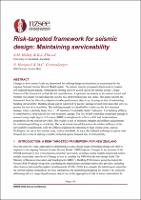Risk-targeted framework for seismic design: Maintaining serviceability

Download
Date
2022-04-27Authors
Hulsey, Anne
Horspool, Nick
Elwood, Kenneth
Gerstenberger, Matthew
Metadata
Show full item recordAbstract
Changes to how seismic loads are determined for building design are imminent, as necessitated by the ongoing National Seismic Hazard Model update. The authors recently proposed a framework to produce risk-targeted hazard spectra, replacing the existing uniform-hazard spectra for seismic design. Unique features of this framework include the full quantification of epistemic uncertainty in the seismic hazard and multiple risk targets for individual and societal risk at the building and city scales. This paper extends the framework from the life-safety objective to other performance objectives, focusing on that of maintaining building serviceability. Building design can be controlled by parallel damage-related limit states that serve as proxies for loss of serviceability. The building strength is controlled by a limit state for low structural damage, where a ductility factor of μ ≤ 1.25 maintains “essentially elastic” behaviour. The building stiffness is controlled by a limit state for low non-structural damage. The risk of drift-controlled component damage is assessed using single degree of freedom (SDOF) assumptions for effective drift and modal analysis assumptions for the critical story drift. The result is a pair of minimum strength and stiffness requirements for maintaining building serviceability. The local seismic hazard determines the relative influence of the serviceability requirements, with the stiffness requirement controlling in high seismic areas, such as Wellington, but not in low seismic areas, such as Auckland. As such, the stiffened buildings in regions with frequent low levels of shaking would be protected against frequent loss of serviceability.
